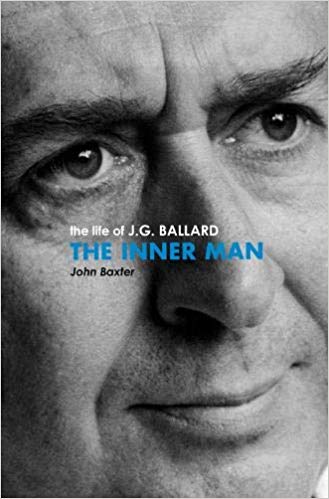 By JOHN BAXTER (Weidenfeld & Nicolson; 2011)
By JOHN BAXTER (Weidenfeld & Nicolson; 2011)
In which England’s incomparable literary genius J.G. Ballard, the esteemed “Dark Prophet of the 20th Century,” gets the John Baxter treatment. This means a less-than-flattering biographical portrait that makes for a good companion-piece to Baxter’s books about Luis Bunuel, Woody Allen and Stanley Kubrick, the latter of which is notorious for its scabrous portrayal of its subject. That’s certainly the case with THE INNER MAN, which unearths all sorts of warty details that didn’t make it into Ballard’s autobiographical novels THE EMPIRE OF THE SUN and THE KINDNESS OF WOMEN, nor his memoir MIRACLES OF LIFE.
The J.G. Ballard presented in those books, and in most media profiles of the man, was a kindly eccentric who through his fiction managed to put his demons, bequeathed by his youthful internment in a Japanese POW camp during WWII, behind him. The Ballard described by John Baxter, in contrast, is a deeply troubled, self-absorbed recluse who used kindness as a shield to keep the world at arm’s length.
Surprisingly, Baxter doesn’t go into much detail about Ballard’s POW camp experiences, which are dispensed with in a single chapter. Far more ink is lavished on Ballard’s early childhood exploits as the son of British expatriates in Shanghai, and his later years, during which he wrote several volumes’ worth of short stories and novels like THE DROWNED WORLD, THE ATROCITY EXHIBITION, CRASH and HIGH-RISE, all the while “clinging resentfully to the fantasy of a lost Shanghai.”
Ballard, according to Baxter, was an “intellectual thug” with a love of illicit sex and violence. He became a novelist after dabbling in psychiatry and advertising copywriting, a profession that provided the impetus for his famously florid prose. He was married—unhappily, Baxter suggests—to one Helen Mary Matthews, who contracted pneumonia and died during a 1964 vacation in Spain. Baxter naturally pins her death partially on Ballard, claiming he insisted on the vacation even though he knew his wife, who had just undergone surgery, wasn’t entirely healthy.
Baxter (a former science fiction writer himself) doesn’t go much easier on Ballard’s fiction, claiming much of THE ATROCITY EXHIBITION was written in an alcoholic stupor, and that most of the biographical details Ballard supplied about his life were untrue (such as Ballard’s claim that a 1970 car crash exhibition he organized caused widespread outrage in its patrons, which according to this book was complete nonsense). Baxter also regales us with details of Ballard’s many affairs, including one with novelist Emma Tennant and another with editor Judith Merrill, as well as his long-term (and abusive) relationship with the late Claire Walsh, in whose home he died.
Ballard’s final years were unhappy ones. Baxter makes much of the messy, dust-ridden house in the English suburb of Shepperton where Ballard lived much of his adult life, and his increasingly reclusive lifestyle. Baxter also makes the claim that Ballard’s relationships with his three children weren’t nearly as idyllic as he made them out to be in MIRACLES OF LIFE.
Some would argue that in focusing so intently on the negative aspects of J.G. Ballard’s life and character John Baxter loses sight of the bigger picture. I suspect that view is at least partially correct, given the things I’ve heard about Ballard—all of them positive—from those who knew him. This book is valuable, I suppose, as a guide to the dark side of J.G. Ballard that isn’t covered elsewhere, but I don’t think it tells the whole story.
